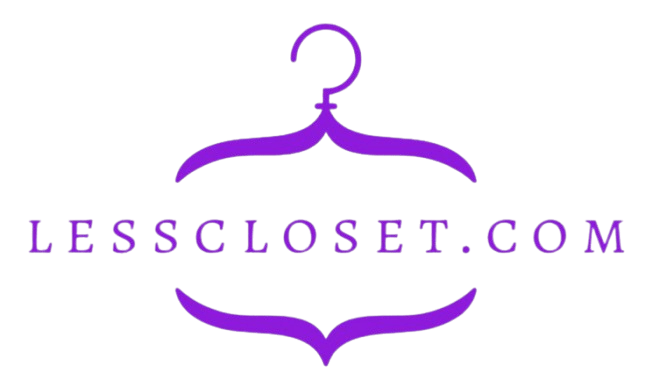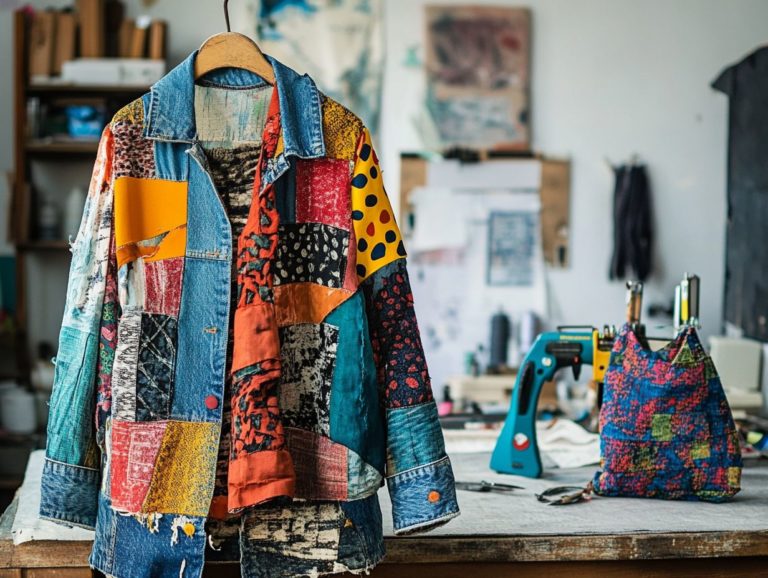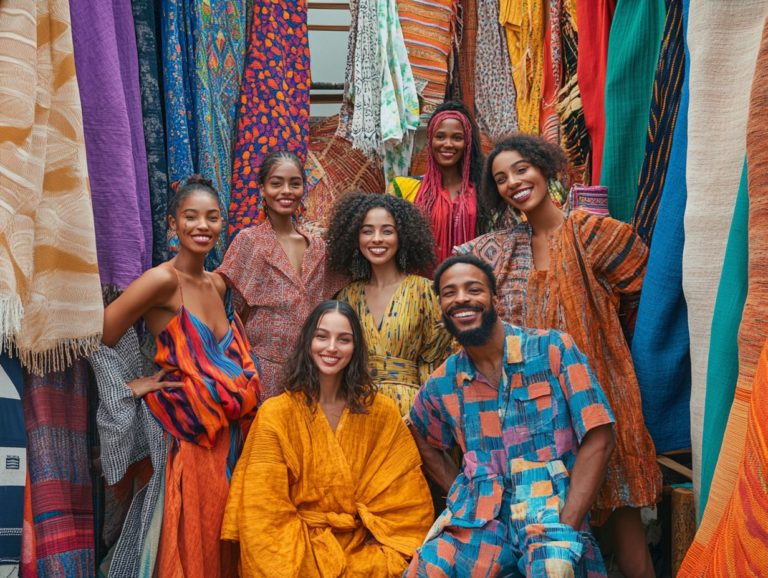How to Evaluate Clothing Quality for Sustainability
In a world dominated by fast fashion, understanding sustainable clothing is vital now more than ever!
This exploration dives deep into sustainability in fashion. You ll discover key factors that enhance clothing quality and ratings from platforms like Good On You.
Learn about materials, production methods, environmental impacts, and worker rights. This knowledge will help you identify what truly makes clothing sustainable.
We ll also highlight essential clothing labels, certifications, and practical tips to help you make mindful shopping choices, like clothing swaps, that enhance the longevity of your wardrobe. Embark on this journey to empower yourself in making informed and ethical fashion decisions.
Contents
- Key Takeaways:
- Understanding Sustainable Clothing
- Factors to Consider for Evaluating Clothing Quality
- Assessing Clothing Labels and Certifications
- Tips for Making Sustainable Clothing Choices
- Frequently Asked Questions
- 1. How can I evaluate the clothing quality for sustainability?
- 2. What materials should I look for when evaluating clothing quality for sustainability?
- 3. Why is the production process important when evaluating clothing quality for sustainability?
- 4. How can I tell if a piece of clothing is durable and will last a long time?
- 5. Are there any certifications like Fairtrade and OEKO-TEX or labels I should look for when evaluating clothing for sustainability?
- 6. Can I still check clothing quality for sustainability when shopping at fast fashion stores?
Key Takeaways:

- Opt for clothing made from eco-friendly materials and sustainable production practices to reduce negative impacts on the planet and promote ethical labor practices.
- Evaluate clothing labels and certifications to ensure they meet sustainable standards. Look for recognized labels to guarantee ethical and eco-friendly production.
- Make sustainable clothing choices by shopping mindfully and extending the lifespan of clothing through proper care and repair. This helps reduce waste and supports a more sustainable fashion industry.
Understanding Sustainable Clothing
Understanding sustainable clothing is crucial for you if you aim to make informed choices that have a meaningful impact on the environment, social equity, and animal welfare.
This concept covers several dimensions, including the materials used in garments, practices within the supply chain, and the overall transparency of fashion brands.
As awareness around challenges like fast fashion the rapid production of inexpensive clothing, which often leads to waste and textile waste continues to rise, initiatives such as Good On You and Fashion Revolution play a pivotal role in guiding you toward more ethical and sustainable choices that resonate with your values concerning people, the planet, and animals.
Defining Sustainability in Fashion
Sustainability in fashion means creating garments that minimize negative impacts on the environment and society while promoting the welfare of both people and animals.
This concept embraces a holistic approach, acknowledging that every thread in the fashion industry is intricately linked to environmental, social, and ethical dimensions. Engaging in sustainable practices allows you to utilize eco-friendly materials like organic cotton, recycled fabrics, and biodegradable fibers, all of which significantly reduce waste and carbon footprints.
Implementing ethical labor practices ensures that workers are treated fairly, reinforcing a commitment not just to environmental stewardship, but also to social responsibility. By weaving these elements together, you can help the fashion industry contribute to a more equitable and sustainable future, paving the way for a thriving ecosystem where creativity and respect flourish side by side.
Factors to Consider for Evaluating Clothing Quality
When evaluating clothing quality, consider several key factors. First, pay attention to the materials used; they are crucial for durability and comfort.
Next, examine the production methods used; they can greatly enhance a garment’s value. Lastly, reflect on the brand’s commitment to sustainability throughout its supply chain, as this speaks volumes about their overall integrity and dedication to the environment.
Join the movement towards sustainable fashion! Start shopping mindfully today!
Material and Production Methods

The materials you choose and the production methods you support impact the sustainability and quality of your clothing.
By opting for natural fabrics like organic cotton and hemp, you reduce your impact on the environment compared to synthetic alternatives that often come from petroleum-based sources.
These eco-friendly choices not only lessen your dependence on non-renewable resources but also foster healthier soil and promote responsible farming practices.
Embracing sustainable production methods such as closed-loop systems and low-impact dyes plays a crucial role in minimizing textile waste. For consumers, understanding what to know about clothing quality is essential, as these processes recycle materials back into production, ensuring garments are crafted with a genuine concern for both the environment and the consumer.
Selecting these materials and techniques means you ll enjoy higher-quality pieces that stand the test of time, effectively tackling the pressing issue of fast fashion and its harmful effects on our planet.
Environmental Impact
The fashion industry has a huge impact on our planet! Fast fashion practices generate substantial waste and greenhouse gas emissions.
Each year, millions of tons of textiles end up in landfills, contributing to pollution. The carbon footprint of clothing production continues to rise, driven by the relentless demand for affordable, trendy items.
This cycle of incessant consumption puts a strain on natural resources and intensifies climate change, making the adoption of sustainable practices more urgent than ever.
By choosing eco-friendly materials, supporting recycling initiatives, and encouraging mindful consumption, you and brands alike can play a pivotal role in mitigating these harmful effects. Act now! Your choices can help save our environment.
Ultimately, embracing a more sustainable approach not only eases the environmental burden but also nurtures a more responsible and conscientious fashion culture.
Worker Rights and Fair Wages
Worker rights and fair wages are essential pillars of sustainability. They ensure that everyone involved in the fashion supply chain receives ethical treatment and fair compensation.
By prioritizing these values, you not only help protect the dignity of workers but also encourage a more transparent and responsible market.
As consumers become increasingly aware of the impact their choices have on both people and the planet, you hold significant power in championing ethical brands.
Organizations like the Ethical Trading Initiative and standards such as Fair Trade offer valuable frameworks that promote these critical rights.
By supporting brands committed to fair labor practices, you contribute to a shift toward a more humane and sustainable fashion industry, influencing practices from the ground up.
Assessing Clothing Labels and Certifications
Assessing clothing labels and certifications is crucial for you as a consumer who values sustainable and ethically produced fashion. By doing so, you gain valuable insights into a brand’s commitment to ethical practices, giving you the power to make informed choices that align with your values.
Recognizing Sustainable Labels and Certifications

Recognizing sustainable labels and certifications gives you the power to identify fashion brands that genuinely prioritize environmental and social responsibility.
This awareness not only fosters mindful purchasing decisions but also supports businesses committed to ethical practices.
Consider certifications such as Fairtrade, the Global Organic Textile Standard, and CDP Climate Change:
- Global Organic Textile Standard (GOTS), which ensures that products are crafted from organically grown fibers, free from harmful chemicals.
- Fair Trade certification, which guarantees fair wages and safe working conditions for all workers involved.
- Better Cotton Initiative (BCI), aimed at enhancing cotton farming practices and promoting sustainability in one of the industry’s most commonly used materials.
By familiarizing yourself with these labels, along with identifying quality in essential clothing items, you can significantly contribute to shaping a more sustainable and equitable fashion landscape.
Tips for Making Sustainable Clothing Choices
Making sustainable clothing choices calls for you to embrace mindful shopping habits that place a premium on ethical production and environmental conservation.
Shopping Mindfully and Ethically
Shopping mindfully and ethically means being attuned to the effects of your fashion choices on people, the planet, and animals.
By taking a moment to research brands and their practices, you can pinpoint those that genuinely prioritize sustainability and social responsibility. It’s about looking beyond the glossy advertisements and investigating how to identify sustainable clothing labels, who is behind their creation, and the materials involved.
When you support sustainable brands, you’re not just reducing your carbon footprint; you’re also empowering workers and championing fair trade. Fair trade means ensuring that workers receive fair wages and work in safe conditions. Staying informed about your consumer rights enables you to advocate for yourself and demand transparency from companies.
With so many options available today, matching your purchases to your values not only amplifies your positive impact but also inspires others to follow suit.
Extending the Lifespan of Clothing
Extending the lifespan of your clothing is not just a smart choice; it s a sustainable practice that significantly reduces waste and encourages smart shopping.
By adopting simple steps such as regular maintenance, proper washing of natural fabrics, and thoughtful storage to minimize waste, you can greatly diminish the need for frequent purchases. Embracing gentle cleaning methods and opting for air drying instead of relying on the machine helps preserve the integrity of your fabrics.
You can also master basic sewing techniques and clothing swaps to mend minor tears or replace missing buttons, which empowers you to repair items rather than toss them aside.
When garments reach a point where they are truly beyond repair, exploring responsible recycling options ensures that your textiles are repurposed rather than sent to landfills. This promotes a circular economy that benefits both people and the planet. To further understand this process, consider reading about the lifecycle of sustainable clothing. This approach not only supports a circular economy but also enhances both environmental sustainability and your personal finances as sustainable brands become increasingly popular.
Frequently Asked Questions

Got questions about sustainable clothing? We have answers!
1. How can I evaluate the clothing quality for sustainability?
Evaluating clothing quality for sustainability can be done by considering a few key factors such as the materials used, the production process, and the overall durability and longevity of the garment.
2. What materials should I look for when evaluating clothing quality for sustainability?
Look for natural, organic materials such as organic cotton, linen, and hemp. These materials are grown without the use of harmful chemicals and have a lower impact on the environment.
3. Why is the production process important when evaluating clothing quality for sustainability?
The production process of a garment can greatly impact its sustainability. Look for clothing made in ethical factories that prioritize fair labor practices and use environmentally-friendly production methods.
4. How can I tell if a piece of clothing is durable and will last a long time?
When evaluating clothing for sustainability, pay attention to the quality of stitching, seams, and overall construction. A well-made garment will have strong, even stitching and reinforced seams, indicating that it will withstand wear and tear.
5. Are there any certifications like Fairtrade and OEKO-TEX or labels I should look for when evaluating clothing for sustainability?
Yes, certifications such as Fair Trade, Global Organic Textile Standard (GOTS), and Bluesign signify that a garment meets certain environmental and ethical standards. Look for these labels when shopping for sustainable clothing.
6. Can I still check clothing quality for sustainability when shopping at fast fashion stores?
Yes! You can check how sustainable the clothing is at fast fashion stores. It can be difficult, but here s how to do it.
Look for items made from natural materials. Check the production process and choose versatile pieces that will last in your wardrobe.






